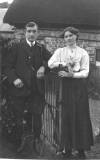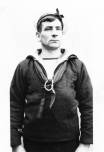
|
| HOME PAGE |
| MEMORIAL CROSS |
| HISTORY of the CROSS |
| ROLL of HONOUR |
| LINKS |
Herbert Beardon was born on 11th October 1888, the son of John Beardon a boot maker who had married Elizabeth Bradford at the same time as John moved from his parents home in Wembworthy to one of the two Penson Cottages in Hollocombe. Herbert was the younger brother of Percy Beardon, who is listed on the Winkleigh Memorial Cross and whose history can be a accessed by clicking HERE. Herbert’s grandfather, also John, had been born in Winkleigh and moved to Bridge Reeve, Wembworthy. He is unusual in that his name then was Passmore, but soon changed his name which was first recorded as Bardens, which eventually became Beardon. All of his daughters married using the name Passmore, but his two sons John and William adopted the name Beardon.
Neither Herbert or his brother Percy rushed to join the war in 1914, but Herbert remained with his parents and became a ploughman in Winkleigh. It was not until 1916 that Herbert joined the Navy. This may have been in response to the Derby Scheme, because with conscription looming the Derby Scheme allowed some latitude of choice as to what to do. By this time, it was becoming apparent that the war was not going to be short and easy, so the Navy possibly offered a more secure future. Herbert went to Devonport for initial training as an Ordinary Seaman on 6th March 1916 and was described as 5ft 5½in tall with dark brown hair, brown eyes and a fresh complexion. After his training he was assigned to HMS Inflexible on 1st of July 1916. The Inflexible was a battlecruiser of the Invincible class and had been commissioned on 20th October 1908 and was armed with 4 × 2 - BL 12-inch (304.8 mm) Mk X guns, 16 × 1 - QF 4-inch (101.6 mm) Mk III guns, 7 × 1 - Maxim machine guns, 5 × 18-inch (450-mm) and torpedo tubes (4 broadside, 1 stern). Her four-shaft Parsons direct-drive steam turbines, with 31 Yarrow water-tube boilers gave her a top speed of 26.48 knots. Prior to Herbert’s assignment the Inflexible had been in operations in the Mediterrean and action in the Dardanelles where she was damaged by return fire and struck a mine while maneuvering. The damage was such that she had to be beached to prevent sinking. In May 1916 she was a part of the Grand Fleet that was at the Battle of Jutland, where a large number of German ships were being blockaded by the Royal Navy. The German Navy started to gather their ships together in hope was that the concentration of ships would lure the Royal Navy’s Grand Fleet, so many could be destroyed and allow Germany’s mercantile fleet to operate. It was also part of a larger strategy to brake the British blockage of Germany. The Grand Fleet was sent to Jutland and the Battle of Jutand took place on 31st May and 1st June and was the largest sea battle ever, before or since, with a total of 250 ships. The Inflexible and damaged some of the German ships, but unfortunately, her sister ship the Invincible was badly hit and finally the magazine exploded and she sank in 90 seconds. During the night of 31st May, the British manoeuvred to restart the battle in the morning, but possibly because of poor intelligence from the Admiralty, the German fleet managed to return to port. However, the result of the battle was indecisive and still remains a contested issue. Germany failed to destroy a substantial part of the British fleet, but the British lost more ships and twice as many sailors. The Inflexible returned safely with the Grand Fleet and Herbert joined her two and half months later. After Jutland there was little significant naval activity for the Inflexible and other battlecruisers of the Grand Fleet other than routine patrolling, thanks to the Kaiser’s order that his ships should not be allowed to go to sea unless assured of victory. Two torpedoes fired by the German submarine SM U-65 during one of these patrols on 19 August 1916 missed astern. Later in 1916 Herbert returned to Devonport for further training to become an Able Seaman and was assigned to HMS Ramilles on 8th May 1917. HMS Ramilles was a Revenge class battleship with 8 x 15in 45cal MK I, 14 x 6in, 4 x 3 pounder, and 2 x 3in guns with 4 x 21in torpedo tubes and a top speed of 21 knots. In common with all the battleships of this class, the 6 inch guns were mounted too low and could be flooded in high seas. She also had anti-torpedo bulges fitted which were filled with materials to reduce the effects of an explosion. Unfortunately, when she was launched on 12 June 1916 the rudder was damaged and the subsequent repairs delayed her delivery and commissioning which was not until 1 September 1917. The Ramillies was towed with some difficulty from Glasgow to Liverpool for the repairs and final fitting-out which took tree months. Because of the delay, there was plenty of leave time and Herbert managed must have visited Winkleigh a number of times before the Ramillies joined the Grand Fleet in Scapa Flow. When the Ramillies went to the Scapa Flow it was unlikely that Herbert would get back to Winkleigh for some considerable time, and this may have been a consideration for Herbert and Mildred de Witt to get married in the summer of 1917. Mildred had been born in 1890 in Plymouth, but sadly her mother died about this time. Her father Charles was a Tea Merchant and then moved to Charles where three of Mildred’s grandparents were living with them, and presumable helped with looking after baby Mildred. Later Mildred went to live and be brought up by her uncle and aunt Edward and Betsy (Williams) Tinney and their two grown up daughters, Jane and Elizabeth, who ran the Ring of Bells in Winkleigh. Sadly there was more tragedy to come for Mable; her aunt died at the age of 60 when Mabel was just 12, and Jane, one of Mildred’s cousins, died when Mildred was 18. Before the Ramillies departed Liverpool she was painted with multi coloured dazzle camouflage. At the end of the war, the Ramillies visited many ports in Scotland and time on shore for the sailors was frequent, although the influenza pandemic made many men ill in November 1918. After the war, the Ramillies continued is service right through to the end of World War II and the Ramillies Association was created. On 21 February 1919 Herbert was demobbed and left the ship to return home with his war gratuity. He continued to live in Winkleigh with Mildred. 1 August 2011 |
|---|
| [Top] | Back to Roll of Honour |

Click on an image for a larger picture |
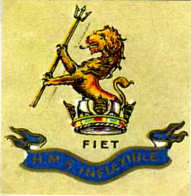
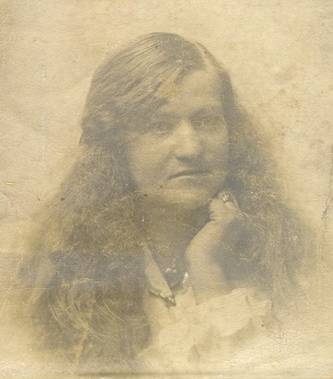 Herbert was one of four children and his mother became the post mistress for Hollocombe Post Office. At the age of 17, Herbert’s sister Hettie became assistant to her mother in the Post Office and eventually took over as post mistress. She continued in this post until she retired at the age of 70. For her 53 years of service to the post office, she received not only a Certificate of Service but a letter of congratulation. Around 1883, Herbert’s family were joined by there uncle William and his growing family who moved into the other Penson Cottage. At this time Maud was born at Penson and would have gone to school with Herbert and his brothers. William and his family left Penson about ten years after Maud was born. Maud Beardon
Herbert was one of four children and his mother became the post mistress for Hollocombe Post Office. At the age of 17, Herbert’s sister Hettie became assistant to her mother in the Post Office and eventually took over as post mistress. She continued in this post until she retired at the age of 70. For her 53 years of service to the post office, she received not only a Certificate of Service but a letter of congratulation. Around 1883, Herbert’s family were joined by there uncle William and his growing family who moved into the other Penson Cottage. At this time Maud was born at Penson and would have gone to school with Herbert and his brothers. William and his family left Penson about ten years after Maud was born. Maud Beardon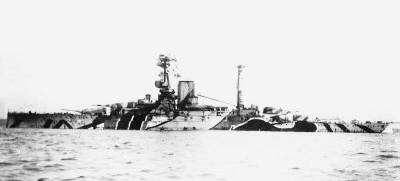 The stripes were a mix of yellow, black, light and dark blue, green, and purple and the pattern was different on the other side of the ship and form those on her sister ship HMS Revenge which was also dazzle painted. This is reported to have been quite a surprise when the Ramillies reached the Grand Fleet, especially as she arrived at night and was lit up with searchlights.
The stripes were a mix of yellow, black, light and dark blue, green, and purple and the pattern was different on the other side of the ship and form those on her sister ship HMS Revenge which was also dazzle painted. This is reported to have been quite a surprise when the Ramillies reached the Grand Fleet, especially as she arrived at night and was lit up with searchlights.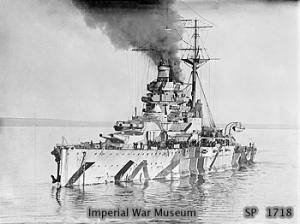 On 20 November 1917 Herbert was promoted to Able Seaman. The patrols with the Grand Fleet were uneventful, but the Ramillies was then fitted with a 600 foot platform for launching an aeroplane. This was successful with the ship steaming into wind for the take off. However, the bi-plane used for the trials was not amphibious so was unable to return the the ship after take off. At a later date a Fairey Flycatcher was used with a catapult.
On 20 November 1917 Herbert was promoted to Able Seaman. The patrols with the Grand Fleet were uneventful, but the Ramillies was then fitted with a 600 foot platform for launching an aeroplane. This was successful with the ship steaming into wind for the take off. However, the bi-plane used for the trials was not amphibious so was unable to return the the ship after take off. At a later date a Fairey Flycatcher was used with a catapult.

